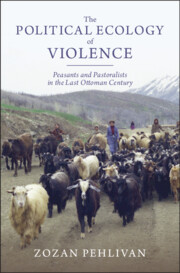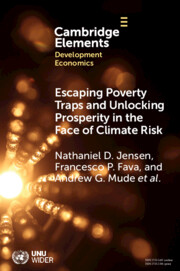Refine search
Actions for selected content:
210 results
The effect of drought on household occupation choices in rural India
-
- Journal:
- Environment and Development Economics , First View
- Published online by Cambridge University Press:
- 24 November 2025, pp. 1-20
-
- Article
-
- You have access
- Open access
- HTML
- Export citation
6 - To Flee or to Fight
-
- Book:
- The Venal Origins of Development in Spanish America
- Published online:
- 11 October 2025
- Print publication:
- 02 October 2025, pp 124-159
-
- Chapter
- Export citation
5 - Irritation
- from Part III - Unsettling Environments: Threat, Loss, and Precarity in Russia’s Peatlands
-
- Book:
- Burning Swamps
- Published online:
- 06 September 2025
- Print publication:
- 25 September 2025, pp 171-197
-
- Chapter
- Export citation
Effects of soil moisture on competition between a central New York State Johnsongrass (Sorghum halepense) biotype and corn
-
- Journal:
- Weed Science / Volume 73 / Issue 1 / 2025
- Published online by Cambridge University Press:
- 11 September 2025, e80
-
- Article
-
- You have access
- Open access
- HTML
- Export citation
2 - The Climate Has Already Changed
-
- Book:
- From Crisis to Action
- Published online:
- 15 August 2025
- Print publication:
- 04 September 2025, pp 28-43
-
- Chapter
-
- You have access
- Open access
- HTML
- Export citation
1 - Why Manage Water with Satellite Remote Sensing?
-
- Book:
- Satellite Remote Sensing for Water Management
- Published online:
- 10 October 2025
- Print publication:
- 04 September 2025, pp 1-17
-
- Chapter
- Export citation
3 - Attribution Science
-
-
- Book:
- The Cambridge Handbook on Climate Litigation
- Published online:
- 03 June 2025
- Print publication:
- 31 July 2025, pp 79-102
-
- Chapter
-
- You have access
- Open access
- HTML
- Export citation
Climate and Human Behavior Studies for Our Warming World: An Introduction to the Models, Methods, and Data
-
- Journal:
- Advances in Archaeological Practice / Volume 13 / Issue 2 / May 2025
- Published online by Cambridge University Press:
- 10 July 2025, pp. 205-222
-
- Article
-
- You have access
- Open access
- HTML
- Export citation
The Other Hand of God: The Impact of the 1988–1989 Drought in Argentina
-
- Journal:
- Latin American Research Review ,
- Published online by Cambridge University Press:
- 01 July 2025, pp. 1-16
-
- Article
-
- You have access
- Open access
- HTML
- Export citation
Where Europe ends, where Africa begins: Transimperial dryland science in the Italian south (1900s–40s)
-
- Journal:
- Journal of Global History , First View
- Published online by Cambridge University Press:
- 27 May 2025, pp. 1-22
-
- Article
-
- You have access
- Open access
- HTML
- Export citation
The Human Cost of Drought – Children at Risk: A Call to Action for Somalia
-
- Journal:
- Disaster Medicine and Public Health Preparedness / Volume 19 / 2025
- Published online by Cambridge University Press:
- 21 May 2025, e120
-
- Article
-
- You have access
- HTML
- Export citation
3 - Migration and Displacement Associated with Aridity, Drought, Heat, and Wildfires
-
- Book:
- Migration and Displacement in a Changing Climate
- Published online:
- 10 April 2025
- Print publication:
- 17 April 2025, pp 95-130
-
- Chapter
- Export citation
1 - Introduction
-
- Book:
- The Water Diaries
- Published online:
- 06 February 2025
- Print publication:
- 13 February 2025, pp 1-12
-
- Chapter
-
- You have access
- Open access
- HTML
- Export citation
3 - “What Will the End [of] This Be?”
-
- Book:
- The Political Ecology of Violence
- Published online:
- 22 November 2024
- Print publication:
- 05 December 2024, pp 136-178
-
- Chapter
- Export citation

The Political Ecology of Violence
- Peasants and Pastoralists in the Last Ottoman Century
-
- Published online:
- 22 November 2024
- Print publication:
- 05 December 2024

Escaping Poverty Traps and Unlocking Prosperity in the Face of Climate Risk
- Lessons from Index-Based Livestock Insurance
-
- Published online:
- 03 September 2024
- Print publication:
- 20 June 2024
-
- Element
-
- You have access
- Open access
- HTML
- Export citation
7 - Aftermath
-
- Book:
- Hydropower in Authoritarian Brazil
- Published online:
- 09 July 2024
- Print publication:
- 27 June 2024, pp 242-270
-
- Chapter
- Export citation
19 - Recent Weather Extremes
- from Part V - Our Changing Climate
-
- Book:
- The Science of Our Changing Climate
- Published online:
- 05 April 2024
- Print publication:
- 02 May 2024, pp 334-354
-
- Chapter
- Export citation
Genetic diversity and morpho-physiological assessment of drought tolerance in rapeseed (Brassica napus L.) cultivars
-
- Journal:
- Plant Genetic Resources / Volume 22 / Issue 3 / June 2024
- Published online by Cambridge University Press:
- 02 April 2024, pp. 181-190
-
- Article
- Export citation
Saving sheep – On extinction narratives in Namibian Swakara farming
-
- Journal:
- Cambridge Prisms: Extinction / Volume 2 / 2024
- Published online by Cambridge University Press:
- 07 March 2024, e1
-
- Article
-
- You have access
- Open access
- HTML
- Export citation
